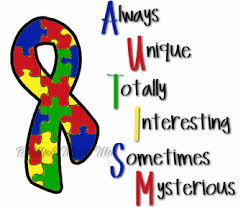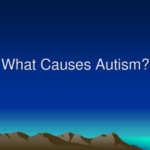
What is Autism?
Understanding a Commonly Diagnosed Developmental Disorder
“Autistic” is a word that is often thrown around when diagnosing children with developmental disorders; what is it exactly, and how can you tell if your child has autistic traits or is experiencing ADHD symptoms? Autism is a spectrum disorder, meaning that people who suffer from this disorder share common difficulties and symptoms though can be affected in different ways.
Autism is one of a group of developmental problems known as autism spectrum disorders, sometimes known as pervasive developmental disorders.
What is Autistic Spectrum Disorder Exactly?
It’s a range of neurological disorders that are characterized by difficulty communicating, social impairments and repetitive patterns of behavior.
If your child is autistic, meaning that it is more difficult for them to develop relationships and interact with others, there are a handful of signs and symptoms that they will exhibit.
These disorders usually appear in early childhood, often before the age of three.The symptoms and severity of the disorders vary, though all affect the social aspect of their lives.
It is estimated that autism is 4 times more likely to affect boys than girls, and is found in all racial and social groups. Approximately 1 in 88 children in the United States have been diagnosed with autism spectrum disorder, which has increased from the past couple of decades. No one is positive about why the rate of people diagnosed with autism has increased, though it could be due to the increase in knowledge of the disorder or the change in diagnostic criteria based on the DSM (Diagnostic and Statistical Manual).
People diagnosed with an autistic spectrum disorder, find it hard to interpret other people’s emotions. When people smile, many people understand that as an expression of happiness. When people frown, many people understand that as an expression of sadness. An autistic individual has difficulty understanding what expressions look like, and can respond by acting strangely in certain situations.
They find it difficult to hold conversations with others and tend to have a lack of interest in people. Instead, they have an increased interest in inanimate objects. They don’t respond well to change and may become distressed if they experience small changes in their world.
Different Types of Autism
There are 5 different disorders that are all classified as an autism spectrum disorder – autistic disorder, Asperger’s disorder, Rett’s disorder, childhood disintegrative disorder, and pervasive developmental disorder – not otherwise specified. The DSM-5 has merged all five of these subtypes into one umbrella diagnosis, though there are a handful of differences in the symptoms of autistic spectrum disorders.
• Autistic Disorder: Less commonly referred to as Kanner’s syndrome, those diagnosed with autistic disorder have very limited emotional connection with anyone and are very routine-based. Those with moderate to severe symptoms can be affected by bright lights, intense smells and loud noises.
• Asperger’s Disorder: The most common type of autism, characterized by clumsiness, due to under-developed motor skills and lack of social skills. They find it hard to communicate with others and tend to have a repetitive nature. This is the subtype of autism that is most commonly misdiagnosed as ADD or ADHD.
• Rett’s Disorder: A rare type of autism that is usually only diagnosed in girls. People diagnosed with Rett’s disorder tend to have muscle atrophy resulting in repetitive hand motions. They are very low-functioning and usually need care for the majority of their lives.
• Childhood Disintegrative Disorder: This is another rare type of autism. It appears in children who seem to be developing normally after birth. As opposed to other types of autism that appear in the first 6-18 months of development, symptoms of childhood disintegrative disorder usually begin to appear around 2-4 years of age. These children begin to regress and show a loss of both motor and conversational skills that they have already developed. They lose interest in interacting and playing with other children.
• Pervasive Developmental Disorder – Not Otherwise Specified: This term is used to describe individuals who show some of the symptoms seen in an autism spectrum disorder, yet do not fit all the criteria needed to be diagnosed with one of the other subtypes.
 Although autism is known as a neurological developmental disorder, some people who suffer from this disorder are referred to as autistic savants – individuals who exhibit extraordinary skills.
Although autism is known as a neurological developmental disorder, some people who suffer from this disorder are referred to as autistic savants – individuals who exhibit extraordinary skills.
These skills appear in a variety of different forms, from being able to complete difficult mathematical calculations in their head ( think Rain Man ) to having impressive artistic or musical abilities.
An autistic savant may be able to remember every miniscule detail about a person or express signs of calendar memory, which allows them to quickly answer questions such as “what day of the week was September 8, 1951?” In autistic individuals, autistic savants are present about 10% of the time. It is  unknown what determines whether or not an autistic person will have extraordinary abilities.
unknown what determines whether or not an autistic person will have extraordinary abilities.
With the rise in the amount of children being diagnosed with autism, it’s important to understand exactly what it is and how it differs from other behavioral and developmental disorders. While ADHD symptoms and symptoms of mental retardation can be similar to those of autism, it’s important to get a correct diagnosis in order to have the most effective treatment possible; increasing knowledge can increase proper treatment.
From our hearts to yours,
Related Posts
-
Symptoms of Autism: What are They?Signs and Symptoms of Autism: What to Watch For If your child has been acting strangely or doesn’t seem to be as socially advanced as others their age, you may be wondering if he or she is displaying some of…
-
Causes of AutismDoes Anyone Really Know What Causes Autism? Autism is a common disorder that affects children in many different ways – some have common types, some have rare types, some experience additional ADD, ADHD, or anxiety symptoms – yet the causes…
-
The Different Types of AutismWhich is Which? Autism - now under a blanket term known as autistic spectrum disorder - is a neurological developmental disorder that affects approximately 1 in 88 American children, though it affects people of all ages all over the world.…
-
Rare Types of AutismRare Types of Autism Many people are familiar with the most common types of autism – Asperger’s Syndrome, an autistic disorder which is a high functioning autism (also known as Kanner’s syndrome), and pervasive developmental disorder not otherwise specified –…

 Although autism is known as a neurological developmental disorder, some people who suffer from this disorder are referred to as autistic savants – individuals who exhibit extraordinary skills.
Although autism is known as a neurological developmental disorder, some people who suffer from this disorder are referred to as autistic savants – individuals who exhibit extraordinary skills.  unknown what determines whether or not an autistic person will have extraordinary abilities.
unknown what determines whether or not an autistic person will have extraordinary abilities.


